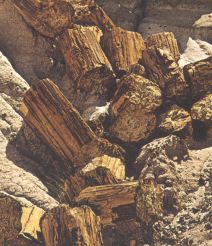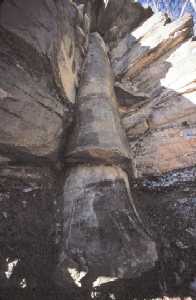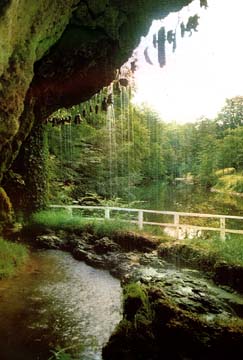
by John P. Pratt and Ronald P. Millett
Reprinted from Meridian Magazine (16 Mar 2005).
©2005 by John P. Pratt. All rights Reserved.
Suppose you were walking through Petrified Forest National Park in Arizona, and among all of the petrified trees, you found a petrified squirrel. Suppose when you examined it, you found that all of its delicate parts such as eyes, lips and fur had been turned to stone, so that it looked exactly like a stone statue of a squirrel. How long do you think it would have taken for the entire petrification process to happen? What is the longest period of time it might have taken before those delicate parts would have decayed?
 |
Okay, so you've never seen a petrified squirrel, but what about a petrified tree? Wood lasts a lot longer than flesh without rotting, but we have likely all seen a fallen log rotting on the ground in the forest. During petrification of wood, the walls of every cell are replaced by a dissolved rock solution, such as a silicate or limestone. This has to happen before the cells decay. What is the longest that the petrification process could take before the log decayed away? And what is the shortest time in which the process could occur in optimum conditions?
On January 25, 2005, an Associated Press release announced that scientists have now succeeded in petrifying wood in only a few days.[1] At the time of this writing, the scientific journal article had not yet been published, so we are relying on the news article's description of the process, used by Yongsoon Shin at the Pacific Northwest National Laboratory. Little blocks of wood less than half an inch on a side from a lumberyard were soaked in a silica solution for a few days. That allowed every cell to become saturated with the rock-forming substance. Then they were heated to 1400 degrees in an oxygen free atmosphere, and the petrified blocks were finished. The reason they made the petrified wood is for commercial purposes. Wood is filled with many little holes, which is why wood floats in water. The petrified blocks are also porous, so that they can be used in processes in which gases need to permeate a large surface area, such as separating industrial chemicals, filtering pollutants, and soaking up contamination.
The news article began with the claim that the scientists "have found a way to achieve in days what takes Mother Nature millions of years --- converting wood to mineral." It was that statement that led to this article, because the shock of seeing that it can be done in a few days caused us to think about exactly how long the process takes to occur in nature.
Does it really take millions of years? It is difficult to see how the process could take that long without having the cell structure of the wood decay. The purpose of this article is to examine the question of just how long it really takes nature to petrify wood. Why is this question being treated in an article in a Science and Religion column? While it would seem that petrifying wood has absolutely nothing to do with religion, that process has been linked to attacks on the Biblical account of the creation of the earth, so it seems appropriate to consider here. It is especially germane to discussions on hard evidence for the world-wide flood described in Genesis. The Flood could have quickly buried forests and also have provided volcanic ash and other ingredients necessary to create petrified wood. But one important question concerns just how long that process would take. So let us begin by looking at exactly what science says about the process.
When we looked up introductory articles about petrification, we found that often very little was said about exactly how long the process is believed to have taken. On the other hand, most articles emphasized the age of the trees. For example, the article in World Book Encyclopedia about "Petrified forest" states that the trees in the six separate forests of Petrified Forest National Park in northern Arizona "grew about 225 million years ago." It reports that they are mostly formed of quartz and opal, two forms of silica. They were said to be buried in mud after being carried by a river, and then water carrying dissolved minerals "fills the empty cells of the decaying wood with this matter until the structure has become solid stone." [2] Thus, this article stated only when the trees were thought to have lived, as dated by fossil animals found in the area, but nothing was said about how long the petrification process took.
On the other hand, many introductory articles do indeed explicitly state that the process took "millions of years." The ones which do not explicitly state the time required, give the impression of eons of time by pointing out that the process occurs "molecule by molecule." While that may sound like it takes forever, that statement actually says nothing about how long the process took. An exploding stick of dynamite also reacts molecule by molecule. We found it an interesting internet search to hunt for the phrase "molecule by molecule" and discover how many articles on petrification use that suggestive phrase.
 |
No explanation whatsoever is given on just what process would magically keep the wood from decaying over those "millions of years" of being buried. That problem is acknowledged, but is glossed over with the sentence, "By a process scientists do not fully understand, many of the trees did not simply break down into their constituent elements." Do not fully understand? They should perhaps say, "By a supposed process difficult even to imagine, which would contradict all known scientific evidence, the trees did not decay for millions of years." The rest of the process they describe all sounds very believable if it were to occur in a matter of months or years. That is, the trees could have been buried quickly under many feet of mud in a flood, which would account for their branches having been stripped off the logs. Then the silica minerals could seep into the cells before they decayed. The only unbelievable feature of the scientific theory is the "million year" part that admittedly has no explanation.
Thus, this Reader's Digest article verifies that the general public has indeed been taught that petrified wood took millions of years to form. But what do scientific experts say?
 |
How do the evolutionists respond? It turns out that when the experts are so confronted, they gleefully announce that they already knew that the petrification process probably only took at most a century. That is the only known way to explain the lack of decay, and this the experts admit. Nevertheless, they point out that the time required is irrelevant to the debate because the trees in Arizona can be dated at some two hundred million years for other reasons, such as the fossils found in the nearby strata. But it is conceded that the actual process of petrification is only believed to have taken a few decades. We find it curious that the time required is almost never mentioned in introductory articles.
Thus, the news article might better have stated that scientists "have found a way to achieve in days what takes Mother Nature decades to do."
Let us here digress slightly to clarify our view of the overall debate between science and religion. Should we expect any solid, irrefutable proof that the scriptures are true before the Savior returns to reign after the wicked have been destroyed, the mountains have flowed down, and the isles have fled? We don't think so for the following reasons.
In Christian Sunday School manuals, the discussion on the existence of God is often only a short paragraph. For example,
"There are millions of stars and planets all in perfect order. They did not get there by chance. We can see the work of God in the heavens and on the earth. The many beautiful plants, the many kinds of animals, the mountains, the rivers, the clouds that bring us rain and snow — all these testify to us that there is a God.[6]
Many of us long for the ultimate proof of the truthfulness of the scriptures to be unearthed, or for the atheistic view of creation to be finally proved false. For those of us who have already had a witness of the Holy Ghost, the amazingly compact DNA code with its programming instructions certainly witnesses of a Divine Programmer. For us, the variety of the plant and animal kingdom and the coordinated body systems in living beings such as the eyes, beak, wings and talons of the eagle certainly testify of a Divine Creator. For us, the wide variety of opinions on the age of various fossils and formations leaves ample room for the Biblical account of the creation and Flood.
During the past ten years this author (Ron Millett) has been privileged to know the details about and encourage John Pratt's research into ancient calendars. It is as powerful a testimony of God and His works as this author has ever seen to witness how the specific dates in the scriptures synchronize with these varied sacred calendars. The Book of Genesis that many consider to be merely "campfire stories" really does have its dates verified by the great clock of the earth, sun, moon and planets to amazing quarter-day accuracy.
But, in spite of these many evidences, we will probably search in vain for the ultimate proofs that will convince everyone. That is because this earth really was created for the purpose of being a testing ground for God's children. It is essential that even though we can receive evidence that encourages us in our journey of faith, the absolute proof of God's existence and details of how he has created and maintained the world will leave many questions unanswered. In fact, for earth life to be a fair test, even the atheistic world view must have plausible and reasonable arguments in its favor.
What if at the end of our own lives, Satan were truthfully able to argue that we had been so favored that he didn't have a fair chance? What if he could say that we had so many compelling proofs of the gospel truthfulness that he couldn't tempt us successfully. He could claim that he must be allowed to exercise power to make the test equal to our preparation during the premortal life. He could claim that the earth test for us had been a sham and that a mistrial should be declared. What would happen if after all of the Divine effort to create the earth, synchronize the solar system, and place God's children to dwell herein, that after all of this, our crucial test was judged as being too easy and that the essential experience of discerning good and evil for ourselves had been short-circuited?
This is why, in our opinion, many of the answers of how the Lord created the earth will be saved for that great day when the Lord promises to tell "things which have passed, and hidden things which no man knew, things of the earth, by which it was made and the purpose and the end thereof."[7] Being among those who have struggled with the persuasive arguments of the many opinions on these issues, we hope to be on the front row when the Lord begins this along awaited presentation.
 |
"There is a well known petrifying stream of water at Knaresborough, Yorkshire, England . . . It is a cascade from the River Nidd, about 15 feet high and twice as broad, and forms an aqueous curtain to the cave known as Mother Shipton's Cave. . . . This cascade has an endless variety of objects hung up by short lengths of wire to be petrified by the water trickling over them, as sponges, books, gloves, kerchiefs and veils, hunter's cap, fox, cat, dog, birds, boots, etc., just as fancy prompts people to seek petrifying results. A sponge is petrified in a few months, a book or cap in a year or two, a cat or bird a little longer. . . . I have a human head petrified, but by what action I do not know. It was found in digging a trench through gravel in the park at Bulstrode, in Buckinghamshire, England."[9]
 |
For example, if in fact such a stream existed in 1889, then why have we never heard of it? Shouldn't it be something like a national monument, or at least a major tourist trap where people can still be found hanging a variety of objects in the stream to make conversation-piece bookends, and the like? When we found the original article in Scientific American, it turned out to be only a letter to the editor, and hence may not have been checked out by the editors as rigorously as a full fledged article. In other words, if there really was such a stream in 1889, is it still petrifying objects today? We had to find out.
Well guess what! The stream is still running, the site is indeed a famous tourist destination, and objects are still being petrified on a regular basis. Go to the web site "www.mothershiptonscave.com/petrifying.htm" and check it out for yourself. You can see in the pictures here, taken from that site, that objects are still being hung in the waterfall, and the process is still occurring naturally, molecule by molecule, in a matter of months.[10]
 |